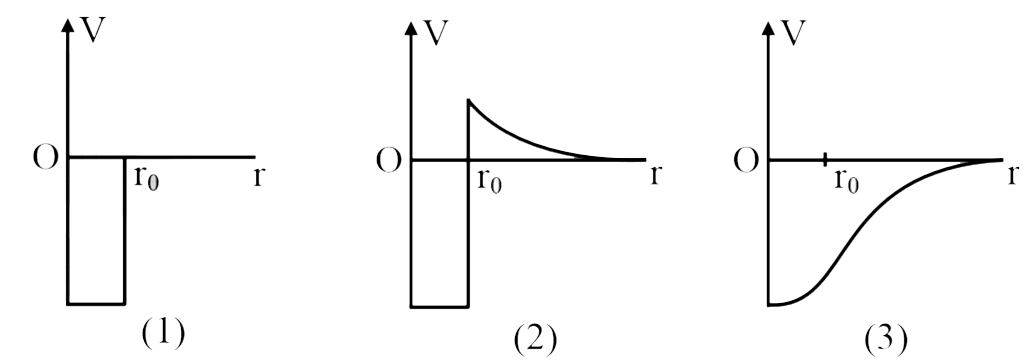Given below are three schematic graphs of potential energy V(r) versus distance r for three atomic particles : electron (e−), proton (p+) and neutron (n), in the presence of a nucleus at the origin O. The radius of the nucleus is r0. The scale on the V-axis may not be the same for all figures. The correct pairing of each graph with the corresponding atomic particle is -

(1,n),(2,p+),(3,e−)
(1,p+),(2,e−),(3,n)
(1,e−),(2,p+),(3,n)
(1,p+),(2,n),(3,e−)
The correct Answer is:A
Step by step video, text & image solution for Given below are three schematic graphs of potential energy V(r) versus distance r for three atomic particles : electron (e^(-)), proton (p^(+)) and neutron (n), in the presence of a nucleus at the origin O. The radius of the nucleus is r_(0). The scale on the V-axis may not be the same for all figures. The correct pairing of each graph with the corresponding atomic particle is - by Physics experts to help you in doubts & scoring excellent marks in Class 12 exams.
Updated on:21/07/2023Topper's Solved these Questions
Similar Questions
A wide bottom cylindrical massless plastic container of height 9 cm has 40 identical coins inside it and is floating on water with 3 cm inside the water. If we start putting more of such coins on its lid. It is observed that after N coins are put, its equilibrium changes from stable to unstable. Equilibrium in floating is stable if the geometric center of the submerged portion is above the center of mass of the object) The value of N is closed to

View SolutionAssertion (A): Nucleus of the atom does not contain electrons, yet it emits β−particles in the form of electrons.
Reason (R): In the nucleus , protons and neutrons exchange mesons frequently.
View SolutionAn alpha-particle accelerated through V volt is fired towards a nucleus . Its distance of closest approach is . r If a protons is accelerated through the same potential and fired towards the same nucleus , the distance of closest approach of proton will be .
View SolutionVelocity (v) versus displacement (s) graph of a particle moving in a straight line is shown in figure. Corresponding acceleration (a) versus velocity (v) graph will be
View SolutionAn α- particle accelerated through V volt is fired towards a nucleus. It distance of closest approach is r. If a proton accelerated through the same potential is fired towards the same nucleus, the distance of closest approach of the proton will be :
View SolutionAn α-particle accelerated through V volt is fired towards a nucleus . Its distance of closest approach is r . If a proton accelerated through the same potential is fired towards the same nucleus , the distance of closest approach of the proton will be :
View SolutionAssertion (A) : Nucleus of the atom does not contain electrons,yet it ewmits beta -particles in the form electrons Reason (R ) : In the nucleus, protons and neutrons exchange mesons frequently
View Solutionएक α-कण V वोल्ट के विभवान्तर से त्वरित होकर किसी नाभिक (परमाणु क्रमांक Z ) से टकराता है। यदि नाभिक की परमाणु संख्या Z हो तो सिद्ध कीजिए कि α-कण की नाभिक के निकटतम पहुँचने की दूरी r0=14.4ZVÅ.
View SolutionSuppose an alpha particle accelerated by a potential of V volt is allowed to collide with a nucleus whose atomic number is Z, then the distance of closest approach of alpha particle to the nucleus is
View Solutionयदि कोई नाभिक इलेक्ट्रॉन कण का उत्सर्जन करे तो इसका न्यूट्रॉन व प्रोटोन का अनुपात (n/p) :-
View SolutionFill in the blanks: The protons and neutron particles present in the nucleus of an atom together are called ____.
View SolutionNucleus contains the three subatomic particles: electrons, protons and neutrons.
View SolutionIf you free a neutron from a nucleus, it will decay into three particles. Two of them are proton and electron. What is the third particle?
View SolutionAssertion (A) : Nucleus of the atom does not contain electrons, yet it emits beta- particles in the form of electrons. Reason (R): In the nucleus , protons and neutrons exchange mesons frequently.
View SolutionVelocity (v) versus displacement (s) graph of a particle moving in a straight line is shown in figure. Corresponding acceleration (a) versus velocity (v) graph will be

View Solution
